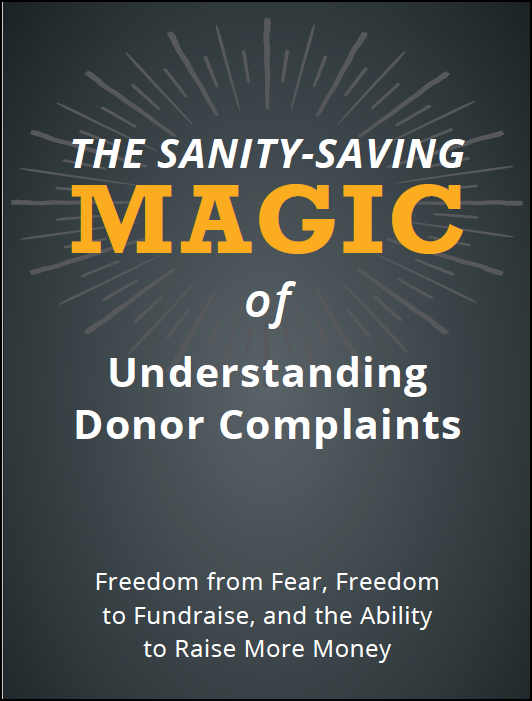Previously we’ve been focused on complaints from external audiences: donors and the occasional non-donor.
Today it’s time to talk about friendly fire: complaints from internal audiences.
I’m using the term “complaints” as a catch-all for actual complaints and internal feedback/suggested changes like, “I don’t like this part because…” and “We can’t say that because…”
Just like complaints from external audiences, complaints from internal audiences happen for lots of different reasons.
Let’s look at some common reasons Fundraisers receive complaints from internal stakeholders. (In case it’s helpful, at the bottom of the post I’ve provided the beginning of a response to each complaint.)
Reasons for complaints:
- The fundraising letter or email “doesn’t sound like us”
- The fundraising shares a situation where a beneficiary needs help
- The fundraising shares a situation where the organization needs help
- The fundraising seems overly simplistic
- The fundraising only shares part of a beneficiary’s story, not all of it
- The fundraising only shares some of what the organization does
- The fundraising lacks data and statistics
- The fundraising does not talk about the quality or effectiveness of our programs
Complaints from internal audiences are complex because they come from stakeholders who wish for the fundraising to succeed, and they are actively trying to help.
However, they are also coming from people who often don’t have the domain knowledge about fundraising to individual donors to know what’s likely to work best, nor do they have the time to learn. To make things even more difficult, what works best in fundraising often appears counter-intuitive
Add those things together and – even though everyone has good intentions – of course you get conflict and tension.
There is no easy way to help internal audiences begin to understand. It usually takes a long-term approach. And a real generosity of spirit, because you’re occasionally challenging peoples’ core values.
First – help internal audiences understand that the fundraising they are providing feedback on is purposefully created to be inclusive in order to grow the organization and its impact. All the complaints above are made about fundraising that is intentionally crafted to be quickly understood by non-experts. Almost by definition, fundraising materials that are created ‘to be quickly understood by non experts’ will not be attractive or motivational to internal experts. Beginning the conversation with an internal stakeholder by showing them how the fundraising is created to be inclusive is successful because it appeals to a value the stakeholder has, instead of telling the stakeholder that they are incorrect and then asking them to learn a whole new way of thinking.
Second – warm, long-term fundraising education is needed. Work with Board and program staff for an hour, every quarter, for at least two years. Share what the experts share. Teach the reasons behind the tactics (like this, for example). Share stories you heard at conferences, and test results shared by experts.
As with external complaints, there will always be internal complaints. In my experience the organizations that live successfully in this tension allow comments on fundraising by anyone, and all comments are responded to. But only a select few people (less than five) have final say about what’s included and what isn’t.
***
PS — The following is in no way meant to be comprehensive, but here are a few quick thoughts to have at the ready when one of these complaints comes in…
- The fundraising letter or email “doesn’t sound like us”
- In direct response fundraising, “directness” and “clarity of communication” give you a better chance at success that any particular voice.
- The fundraising shares a situation where a beneficiary needs help
- One of the purposes of nonprofits is to bring awareness to the public of the need that exists. If we only share successes, we are accidentally hiding the need. Because some donors are motivated by need, and some donors are motivated by success, if we never mention need we are reducing how much money we can raise and how much good we can do.
- The fundraising shares a situation where the organization needs help
- People understand that we are a nonprofit and that we need help sometimes. If we never share that we need help, one of the consequences is that it sounds like we’re “taking care of everything” and less funding will come in. It is good to be vulnerable.
- The fundraising seems overly simplistic
- The fundraising only shares part of a beneficiary’s story, not all of it
- Staff and Board members are experts in our work, plus they have the time and interest to know and understand the whole picture. Most of our donors and readers are non-experts who only look at our fundraising for a few moments. If we require them to know the whole story before they donate, we’ve put up a barrier to them making a donation.
- The fundraising only shares some of what the organization does
- Individual donors tend to have different values than foundations or grantors. They are less interested in “all of our work” and tend to be more interested in “one part of our work.” So our direct response fundraising to individual donors focuses on the parts of our work that they are most interested in.
- The fundraising lacks data and statistics
- Data and statistics are valuable to experts who have the context to quickly understand them. The vast majority of individual donors don’t have the knowledge and expertise that we have. That’s why a compelling story about a beneficiary is more likely to make an impact on a donor than a statistic.
- The fundraising does not talk about the quality or effectiveness of our programs
- As a rule, fundraisers have found that individual donors are more likely to give gifts when their emotions are touched, as opposed to when they are told that an organization’s programs are effective. (This is in contrast to Foundations or Grantors, who rightly pay lots of attention to the quality of an organization’s programs.) So our fundraising to individual donors is purposely designed to engage a donor’s emotions more than it’s designed to communicate that our programs are effective.
***
PPS — I should mention that there are more and more people in the nonprofit world who do not like fundraising at all. They believe that organizations should not have to fundraise.
As you might imagine, people with this belief tend to dislike almost everything about fundraising because the whole operation offends them. They can find something to change or complain about in any piece of fundraising. Your organization could win a big award for having compassionate and effective fundraising… and a person with this belief would criticize the practice of giving out awards for fundraising.
While I sympathize with some of their thinking, I try to keep them as far away from the creation and evaluation of fundraising as possible.
Here’s why, and it’s important: in my experience, people who do not like fundraising (and/or believe that it shouldn’t have to exist) tend to desire and create fundraising for the world they would like to be living in.
And fundraising that’s created for any world other than the world that donors are living in will not work very well.
So, if they are working on your fundraising, the changes they will make will tend to make your fundraising raise less money.
But what can you do about this? Frankly, you have to remove them from the creation and evaluation of fundraising.
To illustrate, say you’re at a nonprofit that has two main programs, Program A and Program B. If there’s a person on Program A who has a philosophical difference about how Program B’s work is done, that person is not invited to participate in program B’s activities. That person should be valued and celebrated for their work on Program A. They can be incredibly effective. But they don’t help Program B do its thing so they aren’t invited to help.
In the same way, if there’s a person on a nonprofit’s team that has a philosophical difference about how the Fundraising team’s work is done, that person is not invited to participate in Fundraising’s activities.
Easy for me to say – I’m a consultant. I don’t have to deal with the friction and personal conflict this can cause. But I’d be remiss if I didn’t point out how this situation causes organizations to create less effective fundraising and achieve less of their mission work.
Read the series:
- Getting Used to Complaints
- Outline for How to Respond to a Complaint
- Not All Complaints are Equal
- Natural, But Not Productive
- The Two Times Smaller Orgs Get More Complaints
- So. Many. Reasons. To. Complain.
- The Harmful Big Assumption
- Turning Complaints into Gifts
- “Friendly Fire” — Complaints from Internal Audiences (this post)
- Our Final Thoughts on Complaints









